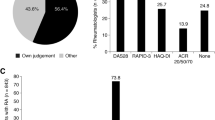Abstract
Several guidelines recommended routine use of Disease Activity Score-28 (DAS28) to monitor disease and the response to treatment for rheumatoid arthritis (RA). In practice, it may be appropriate to use historical erythrocyte sedimentation rate (ESR) values in place of same-day ESR, thereby preventing unnecessary delay in adjusting intervention. We asked whether ESR blood samples taken up to 3 months prior to the clinic appointment were adequate to accurately assess RA disease activity using the DAS28. RA patients (N = 66) who met the inclusion criteria were assessed at baseline and ESR obtained on the day of review to calculate the DAS28 and compared with the DAS28 derived from the latest previous ESR (mean interval, 38.6 days; range, 6–99 days). Limits of agreement (LoA) were used to assess the agreement between the DAS28 pairs. The mean age of the participants was 61.5 years (range, 20–83 years), with mean disease duration of 11.0 years (range, 0.1–40 years). Comparing the DAS28 using same-day ESR versus pre-recorded historical ESR showed a small statistical difference (mean, −0.09; 95 %CI, −0.1602 to −0.017) in the DAS28 score. The calculated LoA (−0.66 and 0.48) demonstrated acceptable agreement between DAS28 pairs, with 7.6 % of patients residing outside the LoA, all of whom had a significant treatment change. Disease misclassification occurred in 9.1 % of patients who were close to disease activity boundaries. Our results indicate that differences in the DAS28 due to a previous or same-day ESR are unlikely to be clinically significant for RA patients with established disease. A decision to adjust treatment therefore may be confidently made for most patients using the most recent ESR for calculating the DAS28, provided there was no major change in treatment since the last ESR measurement.




Similar content being viewed by others
References
Wolfe F, Rasker JJ, Boers M, Wells GA, Michaud K (2007) Minimal disease activity, remission, and the long-term outcomes of rheumatoid arthritis. Arthritis Rheum 57:935–942
Smolen JS, Aletaha D, Bijlsma JW et al (2010) Treating rheumatoid arthritis to target: recommendations of an international task force. Ann Rheum Dis 69:631–637
Smolen JS, Breedveld FC, Eberl G et al (1995) Validity and reliability of the 28 joint count for the assessment of rheumatoid arthritis activity. Arthritis Rheum 38:38–43
Deighton C, Hyrich K, Ding T et al (2010) BSR and BHPR rheumatoid arthritis guidelines on eligibility criteria for the first biological therapy. Rheumatology 49:1197–1199
Smolen JS, Landewé R, Breedveld FC et al (2010) EULAR recommendations for the management of rheumatoid arthritis with synthetic and biological disease-modifying antirheumatic drugs. Ann Rheum Dis 69:964–975
Saag KG et al (2008) American College of Rheumatology 2008 recommendations for the use of nonbiologic and biologic disease-modifying antirheumatic drugs in rheumatoid arthritis. Arthritis Rheum 59:762–784
National Institute for Clinical Excellence (2007) Adalimumab, etanercept and infliximab for the treatment of rheumatoid arthritis. http://www.nice.org.uk/nicemedia/live/11867/37916/37916.pdf. Accessed 27 September 2010
Aletaha D, Ward MM, Machold KP et al (2005) Remission and actives disease in rheumatoid arthritis: defining criteria for disease activity states. Arthritis Rheum 52:2625–2636
Van der Heijde DM, Van’t Hof MA, Van Riel PL et al (1990) Judging disease activity in clinical practice in rheumatoid arthritis: first step in the development of a disease activity score. Ann Rheum Dis 49:916–920
Van Gestel AM, Prevoo ML, Van’t Hof MA et al (1996) Development and validation of the European League against Rheumatism response criteria for rheumatoid arthritis. Arthritis Rheum 39:34–40
Prevoo M, Van’t Hof MA, Kuper HH et al (1995) Modified disease activity scores that include twenty-eight joint counts: development and validation in a prospective longitudinal study of patients with rheumatoid arthritis. Arthritis Rheum 38:44–48
Grigor C, Capell H, Stirling A et al (2004) Effect of a treatment strategy of tight control of rheumatoid arthritis (the TICORA Study): a single blinded randomised controlled trial. Lancet 364:263–269
Goekoop-Ruiterman YPM, de Vries-Bouwstra JK, Allart CF et al (2005) Clinical and radiographic outcomes of four different treatment strategies in patients with early rheumatoid arthritis (the BeSt Study): a randomized, controlled trial. Arthritis Rheum 52:3381–3390
Acknowledgments
The authors would like to express their deepest gratitude to Mr Richard A Parker (Centre for Applied Medical Statistics, University of Cambridge, UK) for his invaluable advice with the statistical analysis of this data.
Disclosures
None.
Author information
Authors and Affiliations
Corresponding author
Additional information
Sven Brode and Muhammad K Nisar contributed equally to this study.
Electronic supplementary material
Below is the link to the electronic supplementary material.
ESM 1
(AI 1126 kb)
Rights and permissions
About this article
Cite this article
Brode, S., Nisar, M.K. & Östör, A.J.K. Same-day or historical ESR for disease activity score measurement: does it matter?. Clin Rheumatol 32, 261–265 (2013). https://doi.org/10.1007/s10067-012-2121-2
Received:
Revised:
Accepted:
Published:
Issue Date:
DOI: https://doi.org/10.1007/s10067-012-2121-2




